
An armoured fighting vehicle or armored fighting vehicle (AFV) is an armed combat vehicle protected by armour, generally combining operational mobility with offensive and defensive capabilities. AFVs can be wheeled or tracked. Examples of AFVs are tanks, armoured cars, assault guns, self-propelled artilleries, infantry fighting vehicles (IFV), and armoured personnel carriers (APC).
This page details tank production by the United States of America during World War II.

The M3 Stuart/light tank M3, was an American light tank of World War II. An improved version of the tank entered service as the M5 in 1942 to be supplied to British and other Commonwealth forces under lend-lease prior to the entry of the U.S. into the war. Afterwards, it was used by U.S. and Allied forces until the end of the war.

The M8 light armored car is a 6×6 armored car produced by the Ford Motor Company during World War II. It was used from 1943 by United States and British forces in Europe and the Pacific until the end of the war. The vehicle was widely exported and as of 2006 still remained in service with some countries.
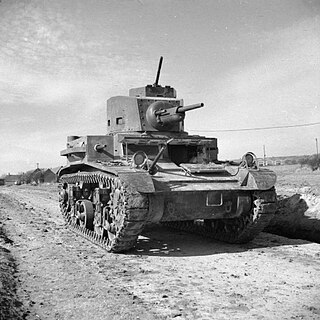
The M2 light tank, officially Light Tank, M2, was an American light tank of the interwar period which saw limited service during World War II. The most common model, the M2A4, was equipped with one 37 mm (1.5 in) M5 gun and five .30 cal M1919 Browning machine guns.

The T17E1 Armoured Car was an American armored car manufactured during the Second World War. It saw service with British and other Commonwealth forces during the war under the name Staghound, but was never used on the front line by US forces. A number of other countries used the Staghound after the war; some vehicles continued to serve until the 1980s.

The M38 Wolfhound was a 6×6 US armored car produced in 1944 by the Chevrolet division of General Motors. It was designed as a replacement for the M8 Greyhound series, but the end of the war in 1945 led to the cancellation of the project after the completion of a handful of prototype vehicles.

An artillery tractor, also referred to as a gun tractor, is a specialized heavy-duty form of tractor unit used to tow artillery pieces of varying weights and calibres. It may be wheeled, tracked, or half-tracked.

The T18 Boarhound was an American heavy armoured car produced in small numbers for the British Army during the Second World War.
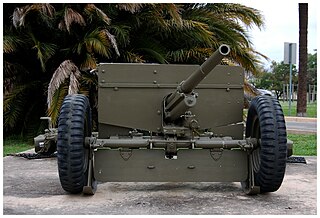
The 37 mm gun M3 is the first dedicated anti-tank gun fielded by United States forces in numbers. Introduced in 1940, it became the standard anti-tank gun of the U.S. infantry with its size enabling it to be pulled by a jeep. However, the continuing improvement of German tanks quickly rendered the 37 mm ineffective and, by 1943, it was being gradually replaced in the European and Mediterranean theaters by the more powerful British-developed 57 mm gun M1. In the Pacific, where the Japanese tank threat was less significant, the M3 remained in service until the end of the war, but some 57mm guns were issued.

The Medium Tank T20, Medium Tank T22 and Medium Tank T23 were prototype medium tanks, developed by the United States Army during World War II. They were designed as successors to the M4 Sherman. The standard main weapon for production versions of these designs was to be the 76 mm M1.

The 75 mm Howitzer Motor Carriage M8 was a self-propelled howitzer vehicle of the United States in use during World War II. It was developed on the chassis of the M5 Stuart tank and was equipped with a M116 howitzer in an M7 mount.
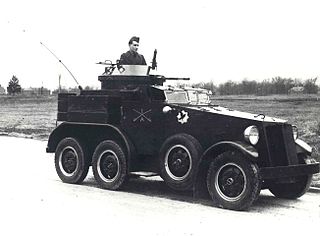
The M1 armored car was a four-wheel drive American armored car tested by the United States Army Ordnance Department in 1931 and briefly in 1932. It was built by James Cunningham, Son and Company of Rochester, New York, and during testing demarcated as the Model T4.
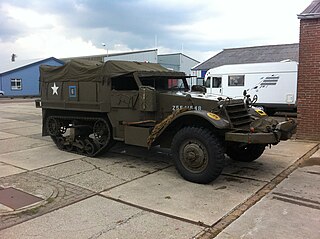
The M5 half-track was an American armored personnel carrier in use during World War II. It was developed in 1942 when existing manufacturers of the M2 half-track car, and M3 half-track could not keep up with production demand. International Harvester (IH) had capacity to produce a similar vehicle to the M3, but some differences from the M3 had to be accepted due to different production equipment. IH produced the M5 from December 1942 to October 1943.
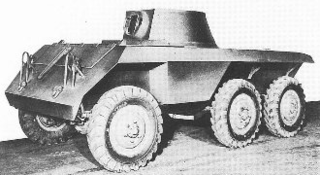
The T23 armored car was an entry from the Fargo Division Chrysler for a new fast tank destroyer to replace the M6 37mm gun motor carriage in July 1941 initiated by the U.S. Army Ordnance Department. Required specification was to be able to withstand fire from a .50 in (12.7 mm) machine gun to the front and side from a .30 in (7.62 mm) machine gun. Although Dwight D. Eisenhower's headquarters were in favor, the design was rejected in favor of the Ford T22.
















